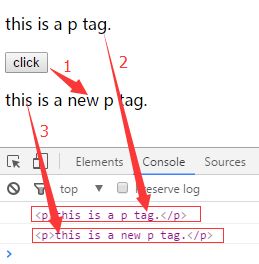关于点击click事件以及事件绑定的方式
Javascript简单地为一个标签绑定事件写法(不单针对button标签):
<button onclick="click_fn()">clickbutton>
<script>
function click_fn(){
console.log(this);
}
script>另一种是用DOM Document对象来绑定事件:
(注:这种写法须先调用$(document).ready(fucntion(){//code…)来防止文档在未完全加载(就绪)之前就运行脚本)
<script>
$(document).ready(function(){//jquery写法
//js写法:window.onload=function(){}
document.getElementById("btn").onclick=function(){
console.log(this);
}
document.getElementsByTagName("p")[0].onclick=function(){
//getElementsByTagName获得的是一种类型的标签数组集合
//你必须明确告诉onclick,你要绑定在第几个标签上
console.log(this);
}
});
script>
head>
<body>
<p>this is a p tagp>
<button id="btn">clickbutton>
body>上面这种简单的绑定有个局限:
重复监听某一事件,后者会覆盖前者,而不会两者先后触发
<script>
$(document).ready(function(){
document.getElementById("btn").onclick=function(){
console.log("first click function");
}
//重写会覆盖原有function
//点击只显示second click function
document.getElementById("btn").onclick=function(){
console.log("second click function");
}
});
script>
head>
<body>
<button id="btn">clickbutton>
body>于是就有了addEventListener(event,function,useCapture):
- 它允许给一个事件注册多个监听器
- 它提供了一种更精细的手段控制事件监听器的触发阶段(可选择冒泡或捕获)
- 事件冒泡:事件流从特定的目标到最不特定的事件目标(document对象)顺序触发
- 事件捕获:事件从未精确的对象(document对象)开始触发
- .它对任何DOM元素都是有效的,而不仅仅是HTML元素
- 参数useCapture(使用捕获)为true时,使用事件捕获;为false时,使用事件冒泡(默认选项为false)
- IE浏览器只支持事件冒泡,不支持W3C标准,因此它也不支持addEventListener,但它提供了另一个函数attachEvent(event,fucntion)
<script>
$(document).ready(function(){
document.getElementById("btn").addEventListener("click",function(){
console.log("first click function")
},false);
document.getElementById("btn").addEventListener("click",function(){
console.log("second click function")
},false);
});
script>
head>
<body>
<button id="btn">clickbutton>
//点击一次之后会先显示first click function,然后再显示second click function
body>jQuery写法(作用同上面的addEventListener):
<script>
$(document).ready(function(){
$("#btn").on("click",function(){
console.log("first click function");
});
$("#btn").on("click",function(){
console.log("second click function");
});
});
script>
head>
<body>
<button id="btn">clickbutton>
body>
以上的事件绑定方式都称为普通事件绑定
而还有一种绑定,叫委托事件绑定
先看一下一个代码例子:
<script>
$(document).ready(function(){
$("button").on("click",function(){
//动态在button后面加一个新的p标签
$("this is a new p tag.
").insertAfter("button");
});
$("p").on("click",function(){
console.log(this);
})
});
script>
head>
<body>
<div>
<p>this is a p tag.p>
<button id="btn">clickbutton>
div>
body>结果:

这就是普通的事件绑定,它对动态增加的标签无法进行事件绑定
我们再来看看下面的代码
<script>
$(document).ready(function(){
$("button").on("click",function(){
//动态在button后面加一个新的p标签
$("this is a new p tag.
").insertAfter("button");
});
$("div").delegate("p","click",function(){
console.log(this);
});
});
script>
head>
<body>
<div>
<p>this is a p tag.p>
<button id="btn">clickbutton>
div>
body>结果:

这就是委托事件绑定:
$(selector).delegate(childSelector,event,data,function)
它是利用冒泡的原理,把事件加到父级上,触发执行效果。
什么意思呢?
当你点击一个新增的标签时,原始加载的DOM结构是没有这个新增标签的,就也就是事件监听是与原始DOM结点进行绑定的。
而你用delegate将要绑定的元素委托给其父元素,也就是当你点击新增元素时,其实响应的是其父元素(逐一向上冒泡,看哪个元素已经被绑定监听事件),而父元素会重新解析一下自己的DOM结构,这时候新增的元素标签就能被解析到了。
上面的delegate方法,我用原生的Javascript简单模拟一下:
<script>
$(document).ready(function(){
$("button").on("click",function(){
//动态在button后面加一个新的p标签
$("this is a new p tag.
").insertAfter("button");
});
//为父元素绑定监听事件
document.getElementsByTagName("div")[0].addEventListener("click",function(e){
//console.log(e.target.nodeName);
if(e.target&&e.target.nodeName=="P"){
//若不限定e.target.nodeName,
//则点击div内的所有对象都能触发该方法
//e.target指的是点击的对象
console.log(e.target);
}
});
});
script>
head>
<body>
<div >
<p>this is a p tag.p>
<button id="btn">clickbutton>
div>
body>jQuery1.9以前的版本用$(selector).live(event,data,function)对delegate()进行了封装,使得看似对新增元素依旧能够绑定成功。但这也使得程序员用得不明不白,我想这也是jQuery后来版本废弃它的原因。
jQuery现在的版本用$(selector).on(event,childSelector,data,function)就可以实现以上的各种功能。
如普通的事件绑定:
<script>
$(document).ready(function(){
$("button").on("click",function(){
$("this is a new p tag.
").insertAfter("button");
});
});
script>对于这种普通的事件绑定,jQuery还提供一种简化版写法(其实就是封装):
<script>
$(document).ready(function(){
$("button").click(function(){
$("this is a new p tag.
").insertAfter("button");
});
});
script>而委托事件绑定的写法:
<script>
$(document).ready(function(){
$("button").click(function(){
$("this is a new p tag.
").insertAfter("button");
});
//委托事件绑定
$("div").on("click","p",function(){
console(this);
});
});
script>参考资料:
- 浅谈Jquery中的bind(),live(),delegate(),on()绑定事件方式
- addEventListener和onclick的区别
- JavaScript事件委托的技术原理探讨示例